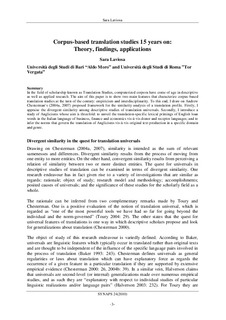| dc.contributor.author | Laviosa, Sara | |
| dc.date.accessioned | 2016-09-12T08:47:31Z | |
| dc.date.available | 2016-09-12T08:47:31Z | |
| dc.date.issued | 2010 | |
| dc.identifier.citation | SYNAPS - A Journal of Professional Communication 24(2010) pp.3-12 | nb_NO |
| dc.identifier.uri | http://hdl.handle.net/11250/2406094 | |
| dc.description.abstract | In the field of scholarship known as Translation Studies, computerized corpora have come of age in descriptive
as well as applied research. The aim of this paper is to show two main features that characterize corpus-based
translation studies at the turn of the century: empiricism and interdisciplinarity. To this end, I draw on Andrew
Chesterman’s (2004a, 2007) proposed framework for the similarity analysis of a translation profile. Firstly, I
appraise the divergent similarity among descriptive studies of translation universals. Secondly, I introduce a
study of Anglicisms whose aim is threefold: to unveil the translation-specific lexical primings of English loan
words in the Italian language of business, finance and economics vis-à-vis donor and receptor languages; and to
infer the norms that govern the translation of Anglicisms vis-à-vis original text production in a specific domain
and genre. | nb_NO |
| dc.language.iso | eng | nb_NO |
| dc.publisher | NHH | nb_NO |
| dc.title | Corpus-based translation studies 15 years on: Theory, findings, applications | nb_NO |
| dc.type | Journal article | nb_NO |
| dc.source.pagenumber | 3-12 | nb_NO |
| dc.source.volume | 24 | nb_NO |
| dc.source.journal | SYNAPS - A Journal of Professional Communication | nb_NO |
